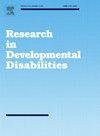对脑瘫患者生活质量的代理和自我报告评估:使用西班牙语版儿童和青少年 CPQOL
IF 2.9
2区 医学
Q1 EDUCATION, SPECIAL
引用次数: 0
摘要
背景提高生活质量(QoL)是对脑瘫(CP)儿童和青少年进行干预的主要目标之一。目的本研究旨在分析脑瘫儿童生活质量的决定因素,包括儿童本人及其父母的评价,并找出评价者之间的差异。方法和程序对 74 名 CP 儿童及其父母(共 222 名参与者)以及功能测量工具(即:GMFCS、MACS、MACS)进行抽样调查,并采用改编的西班牙文版儿童和青少年脑瘫生活质量(CP-QOL)(自我报告版和主要照顾者报告版)、GMFCS、MACS、CFCS 和 EDACS)。儿童的平均年龄为 12.50 岁(SD=4.07),男孩的比例较高(55.7%)。结果在两次评估中,功能维度的 QoL 水平最低(儿童/青少年的 M=70.21,家长的 M=58.14)。对儿童而言,评分最高的维度是 "社会福祉"(M=74.54),而对家长而言,评分最高的维度是 "学校"(M=71.03)。在几乎所有维度上,评价者之间的一致程度都很低(ICC≤.40)。除了 "获得服务 "维度外,由家长进行的评价建立的预测模型更令人满意,功能测量是预测 QoL 水平的主要因素。本文章由计算机程序翻译,如有差异,请以英文原文为准。
Proxy- and self-report evaluation of quality of life in cerebral palsy: Using Spanish version of CPQOL for Children and adolescents
Background
Promoting quality of life (QoL) is one of the main goals in interventions carried out with children and adolescents with cerebral palsy (CP).
Aims
The aim of this study was to analyze the determinants of QoL in children with CP, including evaluations by the children themselves and their parents, and to identify discrepancies between evaluators.
Methods and procedures
The adapted Spanish version of the Cerebral Palsy Quality of Life (CP-QOL) for children and adolescents (self-report and primary caregiver-reports versions) was applied to a sample of 74 children with CP and their respective parents (totaling 222 participants), as well as instruments to measure functioning (i.e., GMFCS, MACS, CFCS and EDACS). The average age of the children was 12.50 (SD=4.07), with a higher number of boys (55.7 %).
Outcomes and results
The lowest QoL levels were found in the Functional dimension in both assessments (Mchildren/adolescents=70.21, Mparents=58.14). For children, the highest rated dimension was Social Well-being (M=74.54), while for parents it was School (M=71.03). The degree of agreement between evaluators was low in almost all dimensions (ICC≤.40). More satisfactory predictive models were constructed from the evaluations carried out by parents, except in the case of the Access to Services dimension, with functioning measures being the main predictors of QoL levels.
Conclusions and implications
The CP-QOL in its two available versions is a useful and specific instrument for assessing QoL in children with CP in both research and professional fields.
求助全文
通过发布文献求助,成功后即可免费获取论文全文。
去求助
来源期刊

Research in Developmental Disabilities
Multiple-
CiteScore
5.50
自引率
6.50%
发文量
178
期刊介绍:
Research In Developmental Disabilities is aimed at publishing original research of an interdisciplinary nature that has a direct bearing on the remediation of problems associated with developmental disabilities. Manuscripts will be solicited throughout the world. Articles will be primarily empirical studies, although an occasional position paper or review will be accepted. The aim of the journal will be to publish articles on all aspects of research with the developmentally disabled, with any methodologically sound approach being acceptable.
 求助内容:
求助内容: 应助结果提醒方式:
应助结果提醒方式:


